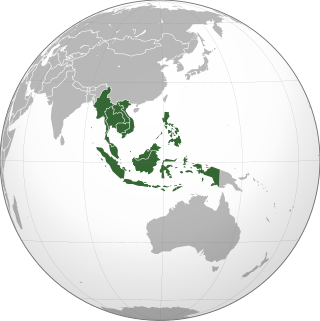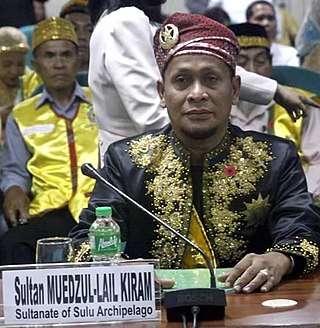
Southeast Asia is the geographical southeastern region of Asia, consisting of the regions that are situated south of China, east of the Indian subcontinent, and northwest of the Australian mainland, which is part of Oceania. Southeast Asia is bordered to the north by East Asia, to the west by South Asia and the Bay of Bengal, to the east by Oceania and the Pacific Ocean, and to the south by Australia and the Indian Ocean. Apart from the British Indian Ocean Territory and two out of 26 atolls of the Maldives in South Asia, Maritime Southeast Asia is the only other subregion of Asia that lies partly within the Southern Hemisphere. Mainland Southeast Asia is entirely in the Northern Hemisphere. East Timor and the southern portion of Indonesia are the parts of Southeast Asia that lie south of the equator.

The United Nations Economic and Social Council (ECOSOC) is one of the six principal organs of the United Nations, responsible for coordinating the economic and social fields of the organization, specifically in regards to the fifteen specialized agencies, the eight functional commissions, and the five regional commissions under its jurisdiction.

The Association of Southeast Asian Nations, commonly abbreviated as ASEAN, is a political and economic union of 10 states in Southeast Asia. Together, its member states represent a population of more than 600 million people and land area of over 4.5 million km2 (1.7 million sq mi). The bloc generated a purchasing power parity (PPP) gross domestic product (GDP) of around US$10.2 trillion in 2022, constituting approximately 6.5% of global GDP (PPP). ASEAN member states include some of the fastest growing economies in the world, and the institution plays an integral role in East Asian regionalism.

A landlocked country is a country that does not have any territory connected to an ocean or whose coastlines lie solely on endorheic basins. Currently, there are 44 landlocked countries, two of them doubly landlocked, and three landlocked de facto states in the world. Kazakhstan is the world's largest landlocked country, Kyrgyzstan is the furthest landlocked country from any ocean, while Ethiopia is the world's most populous landlocked country.

The Asia–Pacific (APAC) is the region of the world adjoining the western Pacific Ocean. The region's precise boundaries vary depending on context, but countries and territories in Australasia, East Asia, and Southeast Asia are often included. In a wider context, Central Asia, North Asia, the Pacific Islands, South Asia, West Asia, and even Pacific-adjoining countries in the Americas can be included. For example, the Asia-Pacific Economic Cooperation (APEC) includes five economies in the New World. The term has become popular since the late 1980s in commerce, finance, and politics. Despite the heterogeneity of the regions' economies, most individual nations within the zone are emerging markets experiencing significant growth. Sometimes, the notion of "Asia–Pacific excluding Japan" (APEJ) is considered useful.
The landlocked developing countries (LLDC) are developing countries that are landlocked. Due to the economic and other disadvantages suffered by such countries, the majority of landlocked countries are least developed countries (LDCs), with inhabitants of these countries occupying the bottom billion tier of the world's population in terms of poverty. Outside of Europe, there is not a single highly developed landlocked country as measured by the Human Development Index (HDI), and nine of the twelve countries with the lowest HDI scores are landlocked. Landlocked European countries are exceptions in terms of development outcomes due to their close integration with the regional European market. Landlocked countries that rely on transoceanic trade usually suffer a cost of trade that is double that of their maritime neighbours. Landlocked countries experience economic growth 6% less than non-landlocked countries, holding other variables constant.

The Small Island Developing States (SIDS) are a grouping of developing countries which are small island countries and small states that tend to share similar sustainable development challenges. These include small but growing populations, limited resources, remoteness, susceptibility to natural disasters, vulnerability to external shocks, excessive dependence on international trade, and fragile environments. Their growth and development are also held back by high communication, energy and transportation costs, irregular international transport volumes, disproportionately expensive public administration and infrastructure due to their small size, and little to no opportunity to create economies of scale. They consist of some of the most vulnerable countries to anthropogenic climate change.

Under the Basic Law, Macau's diplomatic relations and defence are the responsibility of the central government of China. Except diplomatic relations and defence, nonetheless, Macau has retained considerable autonomy in all aspects, including economic and commercial relations, customs control.

The United Nations geoscheme is a system which divides 248 countries and territories in the world into six continental regions, 22 geographical subregions, and two intermediary regions. It was devised by the United Nations Statistics Division (UNSD) based on the M49 coding classification. The creators note that "the assignment of countries or areas to specific groupings is for statistical convenience and does not imply any assumption regarding political or other affiliation of countries or territories".
The University of the Thai Chamber of Commerce (UTCC) is a private non-profit higher education institution in Bangkok, Thailand. The university's origin dates back to 1940, with the foundation of the College of Commerce in Bangkok. In 1984, the college was granted full university status under its present name.

The following outline is provided as an overview and topical guide to Singapore:

The Act East policy is an effort by the Government of India to cultivate extensive economic and strategic relations with the nations of Southeast Asia to bolster its standing as a regional power and a counterweight to the strategic influence of the People's Republic of China.
The Small Five Group or S-5 is a group of five small member states of the United Nations that works to improve the working methods of the Security Council. Its main goal is to increase transparency, accountability, and access for non-members.

Muedzul Lail Tan Kiram is the head of the Royal House of Sulu, a position which he has held since 16 February 1986. As the eldest son of the former Sultan Mohammad Mahakuttah Abdulla Kiram, he is a claimant to the throne of the Sultanate of Sulu. As the last Crown Prince officially recognized by the Philippine government, he is the 35th Sultan of Sulu.
Alounkeo Kittikhoun is a Laotian diplomat and statesman. He served as Minister to the Prime Minister's Office from 2016 to 2020 and Vice Minister for Foreign Affairs of Laos, and was the country's ASEAN Senior Officials Meetings (SOM) Leader. Prior to his Vice Ministerial role, Kittikhoun was Assistant Minister for Foreign Affairs (2007-2011). This position was preceded by his service as the Lao Ambassador and Permanent Representative to the United Nations in New York (1993-2007). Kittikhoun is noted for maintaining the longest length of service as a Lao diplomat, and is one of the longest-serving Ambassadors at the United Nations.
The United Nations Office of the High Representative for the Least Developed Countries, Landlocked Developing Countries and Small Island Developing States (UN-OHRLLS) is an office of the United Nations Secretariat which deals with the Least Developed Countries, Landlocked Developing Countries, and Small Island Developing States. It was founded in 2001 by United Nations resolution 56/227.

The Forum for East Asia-Latin America Cooperation or is a regional forum of 36 countries constituting the region of East, Southeast Asia, Oceania, and Latin America that came together to form an official and regular dialogue channel between the two regions.

The countries of the Bay of Bengal include littoral and landlocked countries in South Asia and Southeast Asia that depend on the bay for maritime usage. Historically, the Bay of Bengal has been a highway of transport, trade, and cultural exchange between diverse peoples encompassing the Indian subcontinent, Indochinese peninsula, and Malay Archipelago. Today, the Bay of Bengal region is the convergence of two major geopolitical blocs- the Association of Southeast Asian Nations (ASEAN) and the South Asian Association for Regional Cooperation (SAARC). The Bay of Bengal Initiative for Multisectoral Technical and Economic Cooperation (BIMSTEC) promotes regional engagement in the area.
The Timor-Leste–Indonesia–Australia Growth Triangle (TIA-GT) is a combined initiative of the regions of Eastern Indonesia, Northern Australia, and the Democratic Republic of Timor-Leste. This initiative aims to promote and foster economic growth through integrated economic development in the region that these nations reside in. The growth triangle was created in 2012, after a meeting was held by Indonesian president Susilo Bambang Yudhoyono with Prime Minister of Australia Julia Gillard and Timor-Leste Prime Minister Xanana Gusmao. The initiative aims to support economic, social, and cultural development primarily by attracting investment, developing manufacturing industries, enhancing human capital, and overall building a stronger cooperative relationship between the three countries involved. The initiative also aimed to accelerate the accession of Timor-Leste into the Association of Southeast Asian Nations (ASEAN) and to fulfill goals set by Timor-Leste's Strategic Development Plan, such as increasing the nation's economic prosperity and stability. The growth triangle is often misinterpreted as a free-trade zone; however, while there are elements of free trade agreements between Indonesia and Australia specifically, the terms of the growth triangle initiative are not directly linked to these free trade agreements, and the goals of the growth triangle do not specifically encompass free trade between the three nations.












